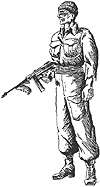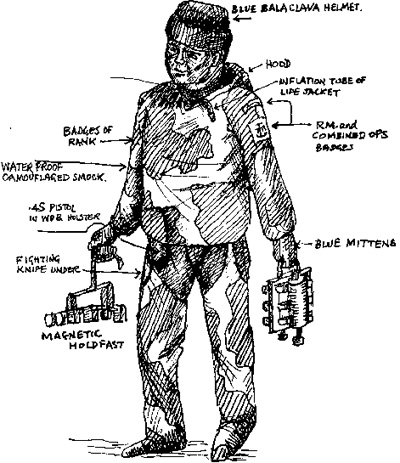 The Commandos, called by Winston Churchill "A steel hand from the sea", gave heart to their beleaguered countrymen by daring and courageous raids on enemy coastlines. They landed and fought on French soil; north of the Arctic Circle; slipped ashore on Axis-controlled Atlantic, Mediterranean and Pacific shores; spearheaded amphibious assaults on D-Day, in North Africa, Sicily and Italy; and were employed as "elite" assault troops in North West Europe. The Rangers, their American counterparts, similarly fought in North Africa, Sicily, Italy, Normandy and the Pacific.
The Commandos, called by Winston Churchill "A steel hand from the sea", gave heart to their beleaguered countrymen by daring and courageous raids on enemy coastlines. They landed and fought on French soil; north of the Arctic Circle; slipped ashore on Axis-controlled Atlantic, Mediterranean and Pacific shores; spearheaded amphibious assaults on D-Day, in North Africa, Sicily and Italy; and were employed as "elite" assault troops in North West Europe. The Rangers, their American counterparts, similarly fought in North Africa, Sicily, Italy, Normandy and the Pacific.
Initially, they fought without artillery and heavy weapons in unsupported surprise actions, relying on well-trained abilities with personal arms. Then, needs changing, fought relatively usually successfully and "conventional" actions in far larger formations; always displaying supreme daring and bravery.
In this article we are mainly concerned with the first type of warfare - raids and small-scale operations that admirably lend themselves to reproduction on the wargames table, where the numbers of men involved can realistically be reproduced in miniature. Thus, the wargamer has at his disposal a completely new and fascinating facet of warfare, involving soldiers, sailors, marines, vehicles and boats of all types; and weapons which, whilst being the arms of today, can be authentically simulated within the confines of an orthodox wargames table.
 Nor is he restricted to relatively conventional military formations that dictate their own movements and tactics. Instead, he is handling forces of widely dissimilar numbers and types there are no establishment lists available for U.S. Rangers – not confined to Commandos and Rangers. Although such formations possess enormous élan and colour, there are innumerable alternative formations and groups bearing such soul-stirring titles as the:
Nor is he restricted to relatively conventional military formations that dictate their own movements and tactics. Instead, he is handling forces of widely dissimilar numbers and types there are no establishment lists available for U.S. Rangers – not confined to Commandos and Rangers. Although such formations possess enormous élan and colour, there are innumerable alternative formations and groups bearing such soul-stirring titles as the:
Special Service Force
Combat Teams
Raider Battalions
Small Operations Group
Special Boat Section
Sea Reconnaissance Unit
Royal Marine Boom Patrol Detachment
Combined Operations Assault Pilotage Parties
Combined Operations Scout Units Amphibian Support Regiment, R.M.
Special Engineering Unit
Royal Marine Engineer Commando
Landing Craft Obstruction Clearance Units [Frogmen who cleared over 2,300 obstacles on Gold Beach @ D-Day! No info on other locations. Kenn]
Raiding Support Regiment
Small Scale Raiding Force
Australian Independent Company
1st Commando Fiji Guerrillas
American Air Commando
Merrill's Marauders
 Operation Frankston: "The Cockleshell Heroes"
Operation Frankston: "The Cockleshell Heroes"
Perhaps Dieppe, St.Nazaire, Gela or other Commando or Ranger battles can be accurately transferred to the wargames table in an attempt to reverse history or to carry out some profound military research. Maybe, by refighting each battle in the correct tactical manner and employing the formations and weapons used in real-life, the wargamer will gain an understanding of the problems of the commanders in the field and an insight into the reconstructions of historical actions must bear basic similarities to real-life events otherwise they become just another wargame.
Drawing by David Barnes. Commando has blue woolen scarf, olive green camoflage waterproof waders, and blackened face, and holds a paair of limpet mines on keeper plate.
To construct a terrain resembling Normandy on D-Day, and manoeuvre infantry, tanks, guns, commandos, airborne troops, and aircraft to complicated rules will produce a conclusion that may coincidently represent the original conflict.
Every aspect of the battle has to be considered in correct context and chronological order, simulated and affected by the fluctuations and fortunes of war, allowing for contemporary Military Possibilities. The wargamer, if desiring authenticity, should not label a battle with its historical title, and then wargame something that in no way resembles it instead of making every effort to reconstruct the original conflict, giving reasonable and realistic consideration to all eventualities that might have occurred, in conjunction with those that actually did occur.
These names provide inspiration for table-top actions that must carry more authenticity and conviction than Borodino re-fought with but 500 model soldiers!
Reconstructing the famous battles of history - Waterloo, Gettysburg, Alamein and others, on the wargames table is fascinating but difficult if not impossible to do with any degree of realism. Notable in the history of the world, these battles involved thousands of soldiers fighting over vast areas of ground at Waterloo there were 100,000 French, 68,000 British, Dutch, Belgian, Germans, and more than 100,000 Prussians. Even if these numbers are drastically scaled-down so that for every 100 men on the battlefield there is but a single figure on the wargames table, with ludicrous infantry battalions of about 7 or 8 men, the wargamer will require at least 3,000 model soldiers. Waterloo, although a "small" battle for the number of troops involved, stretched across a frontage of about four miles; so the most pared-down ground scale still requires an impossibly large wargames table. Alamein was fought for eleven days on a 38 miles front, presenting almost insurmountable re-creation difficulties.
Recent military history has smaller actions with small numbers that allow realistic scaling-down, and are highly suitable for re-production. It is important, if the battle is to bear anything more that a titular resemblance to the original, that the table top armies represent accurate proportions, in numbers and types, of the original formations.
British Commando and U.S. Ranger operations of World War Two are well suited to simulation in miniature on the wargames table, because of the relatively small numbers of men involved and the comparatively confined battle-areas that enable wargames to be fought on a "man-for-man" basis i.e. 1 man in real-life = 1 model soldier on the table-top battlefield. The size and topographical features of historical battlefields must lend itself to being reproduced on the wargames table and almost all Commando and Ranger combat fields seem suitable in area and frontage for this purpose. And, every one of these actions possesses tactical and human interests making it worthy of simulation.
An essential aspect in the reconstruction of historical battles is good documentation including even minor details; the amphibious raids of World War Two explicitly described in numerous readily available books published since World War Two.
Back to Table of Contents -- Lone Warrior # 147
Back to Lone Warrior List of Issues
Back to MagWeb Magazine List
© Copyright 2004 by Solo Wargamers Association.
This article appears in MagWeb.com (Magazine Web) on the Internet World Wide Web.
Other articles from military history and related magazines are available at http://www.magweb.com
